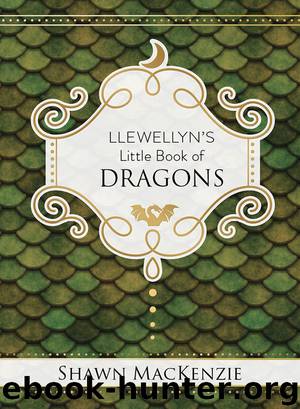Llewellyn's Little Book of Dragons by Shawn MacKenzie

Author:Shawn MacKenzie
Language: eng
Format: epub
Tags: CVR04262019;CVR06062019;dragon;dragons;little book of dragons;llewellyn's book of dragons;llewellyns little book of dragons;shawn mckenzie;what are dragons;working with dragons;how to work with dragons;CVR07102019;CVR09202019
Publisher: Llewellyn Worldwide, LTD.
Published: 2019-12-04T18:46:24+00:00
Hero-kings were on the rise. Marduk, Enki, Cadmus, Thraetona. They needed quests and feats of glory to solidify their places as leaders of men. What better than to slay the old Dragon-gods, to clear the way for the new. One particular hero comes to mind: Keresaspa of ancient Mesopotamia. According to Sumerian lore, Keresaspa killed not one Dragon, but two. First, he took on Gandareva, a Dragon so large he stretched from the ocean depths to the stars above. Their battles lasted for days. Keresaspa was battered and blinded, his horses killed, his family abducted. But, in the end, human heroics triumphed and Gandareva was slain. Unfortunately, even the sweetest victories have consequences. Unbeknownst to Keresaspa, Gandareva watched over a far blacker, more dangerous Dragon, Azhi Dahaka. As the Zoroastrians tell it, after much rampaging and wanton feasting on cattle, camels, and humans, he was captured and imprisoned beneath Mount Demayand. There he stayed for centuries until, come the end times, he broke free. In a feat of Dragon-slayer/messianic bravado, Keresaspa returned to dispatch him and save the world.
Thus the new template for handling Dragons was set, and the course of Dragon history was changed. And for centuries, everything we thought we knew about them changed as well … it had to.
Once upon a time, our ancestors knew Dragons were social beings with enchantments and weyrs that resembled human clans and villages. But it’s hard to demonize someone you know has little ones waiting on supper back home. Where gods stand apart, monsters must be set apart. So, we abandoned Dragons out in the dark—not firing the way to the stars as they once did, but hungry and cold as the night itself. Facts be damned, we turned them into solitary creatures without kith, kin, or the joy of companionship, distanced from offering and hymn, from their place in the light. This was the story now told, the justification of the Dragon slayer: that they were ugly and cruel, rapacious and predatory. That they were Evil.
And as we know, it’s a hero’s duty—even his right—to destroy evil. Right?
Some Dragons chose to stand their ground and defend the weyrs they’d called home since before humans walked erect. Still more, especially those with young ones in tow, chose survival as the better part of valor. In what was to be the first recorded draconic diaspora, they left behind the world of men and withdrew deep into the wilderness. Of course, humans became the sole narrators of history in their absence, and for millennia the lies about Dragons not only persisted—they grew.
Medieval Dragons: Christianity, the Dark Times, and the Great Migration
The history of Medieval Dragons is largely one of the Western weyrs. The isolating geography and politics of the East meant that, until the nineteenth century, Eastern Dragons might as well have been living on another planet, a place mysterious, secure, and protected. True, there were reports of draconic creatures ambling along the Silk Road or frolicking in the Yellow Sea off Hangzhou,
Download
This site does not store any files on its server. We only index and link to content provided by other sites. Please contact the content providers to delete copyright contents if any and email us, we'll remove relevant links or contents immediately.
| Ancient & Controversial Knowledge | Ghosts & Hauntings |
| Hermetism & Rosicrucianism | Magic Studies |
| Occultism | Parapsychology |
| Supernatural | UFOs |
| Unexplained Mysteries |
Animal Frequency by Melissa Alvarez(4394)
Sigil Witchery by Laura Tempest Zakroff(4179)
Real Magic by Dean Radin PhD(4073)
Fingerprints of the Gods by Graham Hancock(3940)
Aleister Crowley: The Biography by Tobias Churton(3586)
Journeys Out of the Body by Robert Monroe(3570)
The Rosicrucians by Christopher McIntosh(3466)
Alchemy and Alchemists by C. J. S. Thompson(3448)
Mysteries by Colin Wilson(3394)
Hitler's Monsters by Eric Kurlander(3268)
The Hatha Yoga Pradipika (Translated) by Svatmarama(3228)
John Dee and the Empire of Angels by Jason Louv(3131)
Wicca: a guide for the solitary practitioner by Scott Cunningham(3127)
Infinite Energy Technologies by Finley Eversole(2938)
Book of Life by Deborah Harkness(2867)
Dark Star Rising by Gary Lachman(2830)
The Book of Lies by Aleister Crowley(2800)
Aliens by Jim Al-Khalili(2787)
To Light a Sacred Flame by Silver RavenWolf(2767)
